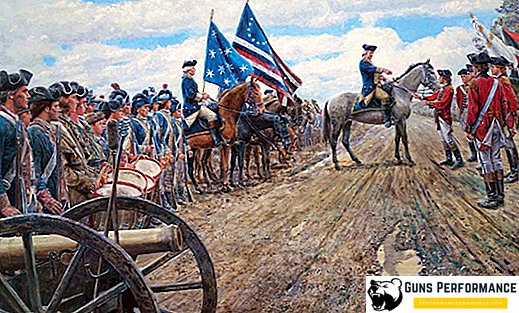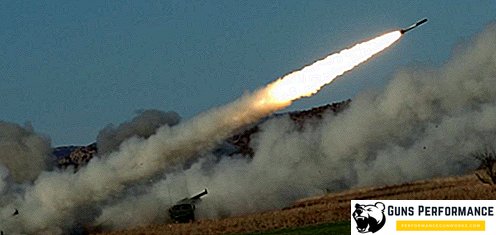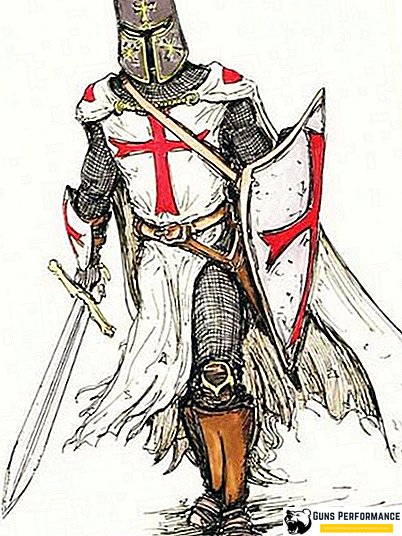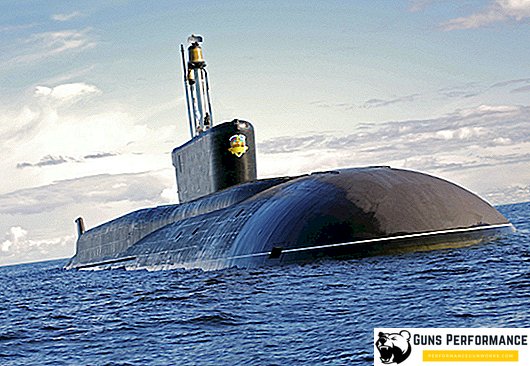The North American colonies of Great Britain in 1776 finally broke off their relations with the metropolis. In 1783, the country was recognized as an independent state, after 6 years the American Constitution came into force. In the XIX-XX centuries to the first 13 states was added another 37, significantly increased the territory of the United States. In the entire history of the country, 45 politicians were in the US presidency, four of them died while serving. The first head of the independent state was George Washington, known throughout the world for his portrait on a one-dollar bill. Now the post of president is Donald Trump, elected in 2017.
The emergence of colonies in North America and their struggle for independence

The history of the development of the United States of America began after the appearance of European colonies at the beginning of the 17th century. The first permanent settlement in North America was the fort and the village of Jamestown in Virginia. The main task of the colonists was survival in the wilderness, full of wild animals and hostile Indian tribes. The settlers who arrived in America did this for several reasons:
- Fled from religious persecution;
- Hoped to master the fertile land;
- They tried to get rich by doing trade, hunting and searching for gold.
The criminals were hoping to escape justice by running across the ocean. British foreign policy did not prevent the bandits from leaving Europe, moreover, the British themselves exiled prisoners to a new colony.
The English colonies gradually grew, with each region developing in its own way:
- In the south there was an agrarian society, huge plantations were founded there, and slave labor was used. The criminals who arrived from England, in accordance with government decrees, were obliged to work for several years with the slaves. At the end of the labor service, they were allocated a land plot and were given the opportunity to start life from scratch;
- The mid-Atlantic regions have become centers of business life. The presence of huge ports quickly enriched the enterprising merchants;
- In the north-east, numerous factories and manufactories were built using raw materials from the southern regions.
In 1756-1763, the Seven Years' War began, England was able to completely oust France from North America. The colonists in this military campaign learned how to fight regular troops, they shed blood in the hope of gaining autonomy from Britain, but the government did not want to make any concessions. In 1775, the war for the independence of the United States began, which lasted until 1783. In 1776, the deputies of the Continental Congress approved the Declaration of Independence, signing the final break of the American colony with the metropolis and ending the era of English rule.
13 United States of America adopted its constitutions, which were based on common fundamental principles:
- Unified management model;
- The separation of powers into legislative, executive and judicial;
- The system of checks and balances, limiting all branches of government.
In 1789, 6 years after the end of the war of independence, the presidential election was held in the United States, and George Washington was elected the first president of the United States.
Civil War and Southern States Reconstruction Program

In April 1861, the greatest civil conflict broke out in the country — the war between the southern and northern states. The confrontation lasted for several years, and this was the only case in the history of the United States of America when the ruling elite could not resolve the conflict by legitimate means. The southern states that formed the Confederation were against the abolition of slavery, and the North fought for the rights of blacks.
Stages of the military campaign:
- In 1861, there was a 34-hour battle for Fort Sumter in Charleston Bay. Southerners seized it, forcing President Lincoln to outlaw southern states;
- In the years 1861-1862 luck was on the side of the southerners. Anarchy reigned in the armies of the North, it was ruled by mediocre commanders;
- In 1863, a change occurred in favor of the North in the war. This happened after the resignations of a number of generals, as well as due to the continuing naval blockade of the ports of the southern states;
- In 1865, the agrarian south, deprived of the opportunity to receive goods and ammunition from Europe, laid down its arms and capitulated.
The victory of the North determined the new domestic economic policy of the USA: it was necessary to rebuild the southern states, to develop industry there. A few days after the end of the war, US President Abraham Lincoln was killed: he was shot and killed in the theater by a southerner, John Wilkes Booth.
United States during the two world wars of the XX century

During the presidency of Thomas Woodrow Wilson, World War I broke out in Europe. Immediately after the start of a global world conflict, the US government declared its neutrality, moving to implement reforms to transform the army. Until 1917, the country remained neutral, at the same time playing the role of the largest trader for the warring parties. By the end of World War I, America had become a trade giant:
- US banks issued huge loans secured by factories and factories;
- Trade corporations have enriched themselves in record time;
- Due to the increase in exports, it was possible to provide jobs for its citizens and enterprises.
In 1917, the US government decided to go to war, hoping to get the maximum profit and capture a number of territories. The administration of President Wilson had to solve two huge problems:
- How to mobilize as soon as possible;
- Ensure the smooth functioning of the economy during the war.
In 1918, the First World War ended with the defeat of Germany and its allies.
In 1929, a crisis began in the country, called the Great Depression. The election of President Roosevelt in 1933 contributed to the stabilization of the economic situation. The Second World War gave America a chance to get out of the crisis, using the working scheme of 1914 - to declare its neutrality and trade with all parties to the combat conflict.
On December 7, 1941, Japan decided on the first step and attacked the American naval base at Pearl Harbor. December 11, Germany and Italy also declared war on the United States of America. Until 1942, the US Army conducted military operations against Japan, which ended with the defeat of the Japanese fleet near Midway Island, which forever deprived the rising sun of a military advantage in the Pacific Ocean.
In 1943, the combined US-British fleet won the battle for the Atlantic and landed troops in North Africa. The first land battles showed that the American army could not be compared with the well-trained troops of the countries of the Hitler coalition. At the same time, the Germans were forced to transfer part of the troops to the Eastern Front, where the fate of the Second World War was decided. Having received technical and numerical superiority, the Americans and British pushed the Germans out of Africa.
In 1944, they opened the Second Front in Europe. The Americans and British, seeing that the Soviet troops had almost finished off the Hitler army, were quick to intervene in the conflict in Europe. On May 8, 1945, Germany signed a capitulation, but the war with Japan continued. Trying to quickly end the fighting and demonstrate their advantage to the Soviet Union, the United States dropped atomic bombs on the Japanese cities of Hiroshima and Nagasaki, which led to the end of World War II.
United States of America in the second half of the XX - early XXI centuries

After the end of the war, the citizens of the United States were confident that the time had come for the "American Century". But on the political map of the world there was another powerful superpower - the Soviet Union. In March 1947, the Truman Doctrine was proclaimed in the United States, which became the catalyst for the Cold War. The American government declared its readiness to confront the USSR, and the arms race began, which lasted several decades.
In the late 1950s, a new stage in the struggle for the rights of black Americans was launched in the United States. In the early 1960s, mass demonstrations and protests took place across the country. Another problem was the war in Vietnam, which provoked an unprecedented surge of youth anti-war speeches.
In 1991, the Soviet Union collapsed, causing widespread rejoicing in the United States of America. It seemed that the "American Century" had come, but the government could not quickly find its way in the new conditions. The terrorist attack of September 11, 2001 revealed a new large-scale threat to the United States - international terrorism in the face of the Islamist organization Al-Qaeda.
In 2008, there was a financial and economic crisis that seriously affected the situation in the country:
- A number of banks have declared themselves bankrupt;
- Businesses closed;
- Tens of thousands of people lost their jobs.
This affected the election campaign of 2008, when Democrat Barack Obama and Republican John McCain fought hard for the presidency. Obama won, becoming the first black president in the history of America.
How to become president of the United States?

Necessary conditions for the presidential nomination:
- Be a US citizen by birth. This requirement did not act immediately after the adoption of the constitution; in those early years, any person who is considered a citizen of the country at the time of the adoption of the constitution could become president;
- Reach the age of 35 years;
- Live in the country for at least 14 years.
In the 22nd amendment to the constitution, adopted in 1951, one more condition is stated: you can become a president for no more than 2 terms, no matter in a row or with a break. Prior to this amendment, Franklin Roosevelt was elected 4 times in a row. In American history there was only one president, elected for two terms, with breaks, this is Grover Cleveland.
The salary of the President of the United States of America is constant and unchanged throughout his term, for example, Obama earned $ 400,000 a year. The constitution strictly stipulates that the head of state cannot receive other income from the US budget. At the same time, the president has the right to engage in publicistic activities.
Powers and Duties of the President of the United States

The head of the United States takes office after the inauguration procedure. By status, the president is the head of state and government, his main rights are:
- Require any senior official written explanations and opinions relating to the activities of departments subordinate to the official;
- Grant pardon or postponement of sentence for crimes against the United States. This right does not apply to the impeachment procedure of the US President or senior officials;
- Conclude international treaties after the approval of their 2/3 senators;
- Fill vacant parliamentary vacancies between sessions. By order of the president, new congressmen are issued certificates;
- To convene extraordinary meetings of the Congress in case of emergency;
- Postpone the meeting of the Congress, if the differences between the chambers can not be solved for a certain period of time. At the same time, the president is free to independently choose the time of new meetings;
- To appoint ambassadors, consuls, and other official representatives of the United States abroad;
- To give prompt and truthful information to the Congress about the state of the country in the given time interval;
- Accept ambassadors and other representatives of foreign countries.
The President of the United States is the Supreme Commander of the country's armed forces.
List of all US presidents by year of government

The presidents of the United States have been elected since 1789:
- 1789-1797 - George Washington. Large slave owner, one of the richest planters in Virginia. He became famous as a fighter for the rights of the colony, after the outbreak of the war of independence he immediately joined the Continental Army, was promoted to commander-in-chief. During his rule, the American Constitution was developed. Re-elected for a second term, refused to run for the third time;
- 1797-1801 - John Adams. Known for the fact that during the presidential campaign was in his house, not participating in it personally. Considered the founder of the US Navy;
- 1801-1809 - Thomas Jefferson. During his reign, America bought Louisiana. Supported the abolition of slavery, reduced the army and navy;
- 1809-1817 - James Madison. A supporter of a tough foreign policy, openly entered into conflict with Spain and England. Forced the latter to recognize the United States at the official level after the war of 1812-1815;
- 1817-1825 - James Monroe. The former governor of Virginia, proved to be an excellent diplomat and politician, appointing a southerner and a northerner as assistant. The author of the famous "Monroe Doctrine";
- 1825-1829 - John Queensley Adams. He was elected to the post by the Congress, although he scored fewer votes than his opponent. I was able to improve relations with Europe;
- 1829-1837 years - Andrew Jackson. Abolished the Second Bank of the United States, became famous as a supporter of the eviction of the Indians;
- 1837–1841 - Martin Van Buren. He tried to separate the state treasury from the banks, but received a rebuff from Congress. He wanted to run for a second term, but was defeated in the election race;
- 1841 - William Harrison. He stayed on duty for only 30 days, died of pneumonia;
- 1841-1845 - John Tyler. Constantly fought with Congress, at the end of his reign joined the USA to the USA;
- 1845-1849 - James Knox Polk. During his presidency, the country conquered New Mexico, California and forced Britain to cede Oregon. The United States has become a major maritime power;
- 1849-1850 - Zachary Taylor. Died in 1850 from a disorder of the digestive system, some historians believe that the president was poisoned;
- 1850-1853 years - Millard Fillmore. The latest president of the Whig United States party. He tried to enlist the support of the Democrats, but this only repelled the Whigs;
- 1853-1857 - Franklin Pierce. The president had to deal with issues related to slavery, Indians, the presence of British merchants in the United States. He played for the aggressive expansion of the country;
- 1857-1861 - James Buchanan. Contributed to the rupture of the North and the South, because of what he was often accused of treason;
- 1861-1865 - Abraham Lincoln. Coming from the people, an ardent opponent of slavery, a fighter for the rights of black people. In 1865 he was killed;
- 1865-1869 years - Andrew Johnson. He advocated the abolition of all the achievements of the Civil War, for which he almost underwent an impeachment procedure. The main event during his presidency was the purchase of Alaska;
- 1869-1877 - Ulysses Grant. Former general, insisting on equal suffrage for whites and blacks;
- 1877-1881 - Rutherford Hayes. He was able to finally reconcile the southern and northern states, restored the metallic currency, fought against corruption;
- 1881 - James Garfield. He sought to expand the influence of America in the world arena, wanted to increase the power of the army and navy. He was shot down by his former supporter, lawyer Charles Gito. The wound was not fatal, but the president died from inept treatment;
- 1881-1885 - Chester Arthur. Known as an implacable anti-corruption fighter, considered the “father” of US civil services;
- 1885-1889 - Grover Cleveland. He was a supporter of the development of free trade;
- 1889-1893 years - Benjamin Harrison. He defended African American voting rights, was the last American president to wear a beard;
- 1893-1897 - Grover Cleveland;
- 1897-1901 - William McKinley. During his presidency, Cuba, the Philippines and Puerto Rico were occupied. He died at the hands of a murderer who believes that he is delivering the States from a tyrant and a despot;
- 1901-1909 - Theodore Roosevelt. He became the youngest president in the history of the United States, received the nickname "world policeman." In 1906 he received the Nobel Prize;
- 1909-1913 - William Taft. He was able to strengthen the role of the state in the economy, was a protege of Roosevelt;
- 1913-1921 - Woodrow Wilson. I tried to keep the country from entering the First World War;
- 1921-1923 - Warren Gardens. He died from a massive heart attack, became famous as a lover of the bohemian lifestyle. Ходили слухи, что его отравили;
- 1923-1929 годы - Калвин Кулидж. Во время его правления Соединённые Штаты пережили бурный экономический бум;
- 1929-1933 годы - Герберт Гувер. В 1932 году выдавал кредиты предпринимателям в надежде, что они будут работать, не увольняя рабочих. Категорически выступал против прямой помощи безработным;
- 1933-1945 годы - Франклин Рузвельт. Единственный президент США, избиравшийся более чем на 2 срока подряд;
- 1945-1953 годы - Гарри Трумэн. Развязал Холодную войну, был активным сторонником образования военного блока НАТО;
- 1953-1961 годы - Дуайт Эйзенхауэр. Закончил войну в Корее, начал строительство автомагистралей по всей стране;
- 1961-1963 годы - Джон Кеннеди. Провёл серьёзные реформы по искоренению расовой дискриминации. Убийство президента США Кеннеди до сих пор считается одной из главных нераскрытых тайн XX века, хотя официальным убийцей был признан Ли Освальд;
- 1963-1969 годы - Линдон Джонсон. Создал "Великое общество", свободное от насилия и бедности. На эту программу Конгресс выделил около 1 000 000 000 долларов;
- 1969-1974 годы - Ричард Никсон. Прославился как президент-миротворец. При нём наладились отношения с Китаем, улучшились отношения с Советским Союзом;
- 1974-1977 годы - Джеральд Форд. Являлся масоном, пережил два неудачных покушения на свою жизнь;
- 1977-1981 годы - Джимми Картер. Прославился как неординарный политик, с одной стороны, предложил Брежневу подписать договор об ограничении стратегического вооружения, с другой - подписал указ о финансировании афганских антикоммунистов;
- 1981-1989 годы Рональд Рейган. Внёс значительные изменения во внутреннюю политику Соединённых Штатов, серьёзно боролся с преступностью в стране;
- 1989-1993 годы - Джордж Буш старший. Обещал вывести Америку на новый уровень развития, но во время его президентства усилилась инфляция и выросла безработица;
- 1993-2001 годы - Билл Клинтон. Самый известный американский президент, благодаря скандалу с Моникой Левински. Смог добиться снижения инфляции, но потерял популярность в результате лжесвидетельствования на суде по делу о сексуальных домогательствах;
- 2001-2009 годы - Джордж Буш младший. Избирался на два срока подряд, в итоге потерял популярность благодаря неумению быстро и эффективно справиться с последствиями от урагана Катрина и экономическим кризисом 2007 года;
- 2009-2017 годы - Барак Обама. Первый чернокожий американец на посту президента Соединённых Штатов Америки. Обещал закрыл тюрьму для подозреваемых в терроризме, но она до сих пор функционирует. В 2009 году получил Нобелевскую премию;
- 2017-наши дни - Дональд Трамп. Является старейшим действующим президентом, вступившим в должность в первый раз.
Некоторые американские президенты удостоились чести размещения своих портретов на национальной валюте страны:
- Вашингтон (1 доллар);
- Джефферсон (2 доллара, редкая банкнота);
- Линкольн (5 долларов);
- Джексон (20 долларов);
- Грант (50 долларов);
- Франклин (100 долларов).
На банкноте в 10 долларов изображён министр финансов Александр Гамильтон.
Резиденция президента США

Белый дом является официальной резиденцией президента Соединённых Штатов Америки. Это грандиозное сооружение служило домом для всех глав государств, кроме Джорджа Вашингтона. Здание, где расположена приёмная президента и работает горячая линия, было построено в 1800 году. Первоначальное его название «Президентский особняк», но впоследствии стало другое, более нам привычное, - «Белый дом». Любой желающий может написать письмо президенту США на адрес его официальной резиденции.
В настоящее время Америка является одним из самых могущественных государств на планете. Президент Трамп утверждает, что он в состоянии поднять экономику страны до немыслимых высот. Сейчас в стране проходит ряд реформ, направленных на возвращение производств в США.












